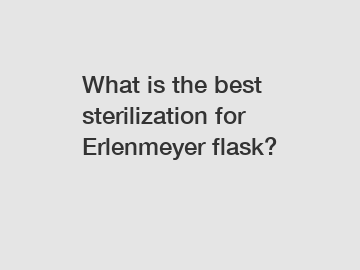What is the best sterilization for Erlenmeyer flask?
Erlenmeyer flasks are commonly used in laboratory settings for mixing, storing, and heating liquids. Sterilizing these flasks is essential to prevent contamination of experiments and ensure accurate results. There are several sterilization methods available, each with its own advantages and disadvantages. In this article, we will discuss the best sterilization methods for Erlenmeyer flasks.
Autoclaving.
Autoclaving is one of the most commonly used methods for sterilizing Erlenmeyer flasks. This process involves placing the flasks in a high-pressure steam chamber at temperatures above 100 degrees Celsius for a specified amount of time. Autoclaving effectively kills bacteria, viruses, and other microorganisms, making it a reliable method for sterilization.

One of the main advantages of autoclaving is that it is a simple and cost-effective method of sterilization. However, it is important to ensure that the flasks are correctly loaded into the autoclave to allow steam to penetrate all surfaces. Additionally, some heat-sensitive materials may be damaged during autoclaving, so it is essential to check the compatibility of the flask material with this method.
Chemical Sterilization.
Chemical sterilization involves soaking the Erlenmeyer flasks in a disinfectant solution to kill microorganisms. Common disinfectants used for sterilization include bleach, ethanol, and hydrogen peroxide. Chemical sterilization is effective for killing a wide range of microorganisms and is often used when autoclaving is not suitable.
One advantage of chemical sterilization is that it is a versatile method that can be used for various materials and surfaces. Additionally, chemical sterilization is often faster than other methods and does not require specialized equipment. However, some disinfectants may be corrosive or toxic, so it is essential to handle them with care and follow safety protocols.
Dry Heat Sterilization.
Dry heat sterilization involves heating Erlenmeyer flasks at high temperatures for a specified period to kill microorganisms. This method is suitable for heat-resistant materials such as glass and metal. Dry heat sterilization is effective for sterilizing flasks that cannot be autoclaved or chemically treated.
One of the advantages of dry heat sterilization is that it does not require the use of water or chemicals, making it a convenient method for sterilizing Erlenmeyer flasks. However, this method may take longer than other sterilization methods and may not be suitable for heat-sensitive materials. It is essential to follow the manufacturer's guidelines and recommendations when using dry heat sterilization.
UV Sterilization.
UV sterilization involves exposing Erlenmeyer flasks to ultraviolet light to kill microorganisms. This method is effective for sterilizing surfaces and helps to prevent contamination in laboratory settings. UV sterilization is often used in conjunction with other sterilization methods to ensure thorough disinfection.
One advantage of UV sterilization is that it is a non-toxic method that does not leave residues on the flasks. Additionally, UV sterilization is quick and easy to perform, making it a convenient option for sterilizing Erlenmeyer flasks. However, UV light may not penetrate certain materials or surfaces, so it is essential to ensure proper exposure for effective sterilization.
Conclusion.
In conclusion, the best sterilization method for Erlenmeyer flasks depends on the materials being used and the specific requirements of the laboratory setting. Autoclaving is a reliable and cost-effective method, while chemical sterilization is versatile and fast. Dry heat sterilization is suitable for heat-resistant materials, and UV sterilization is effective for preventing contamination. It is essential to consider the advantages and disadvantages of each sterilization method before choosing the best option for your needs.
If you have any questions or need further assistance with sterilizing Erlenmeyer flasks, please feel free to contact us. We are here to help you maintain a sterile laboratory environment and achieve accurate results in your experiments.
For more information, please visit t-25 flasks, types of lab flasks, roller bottle sizes.

Comments